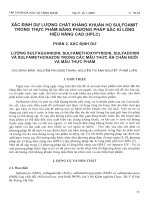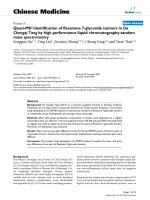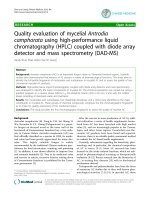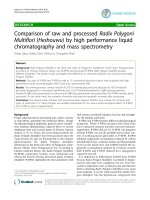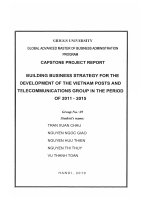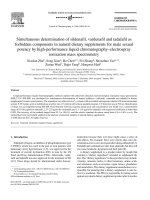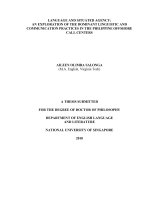The pharmacokinetics, bioavailability and excretion of bergapten after oral and intravenous administration in rats using high performance liquid chromatography with fluorescence detection
Bạn đang xem bản rút gọn của tài liệu. Xem và tải ngay bản đầy đủ của tài liệu tại đây (1.04 MB, 8 trang )
Yu et al. Chemistry Central Journal (2016) 10:62
DOI 10.1186/s13065-016-0212-x
RESEARCH ARTICLE
Open Access
The pharmacokinetics, bioavailability
and excretion of bergapten after oral
and intravenous administration in rats using
high performance liquid chromatography
with fluorescence detection
Xie‑an Yu1†, John Teye Azietaku1†, Jin Li1, Mingrui An2, Jun He1, Jia Hao1, Jun Cao3* and Yan‑xu Chang1*
Abstract
A sensitive, specific, reproducible and optimized high performance liquid chromatography with fluorescence detec‑
tion (HPLC-FLD) method for the determination of bergapten in rat plasma was established and applied to the
pharmacokinetic and bioavailability study in rat after oral and intravenous administration of bergapten. The method
was also successfully applied to the excretion study of bergapten after an oral administration of bergapten at a dose
of 15 mg kg−1 to rats. The sample preparation was achieved using liquid–liquid extraction. Isoimperatorin was used as
the internal standard (IS). The analytes were detected by using fluorescence detection at an excitation and emission
wavelength of 288 and 478 nm, respectively. Using aqueous formic acid (0.1 %, v/v) and acetonitrile as the mobile
phase, the chromatographic separation was achieved on a Hedera™ ODS column at a flow rate of 1 mL min−1. The
lower limit of quantitation (LLOQ) of bergapten was 2 ng mL−1. The HPLC-FLD method was successfully applied to the
pharmacokinetic, bioavailability and excretion study of bergapten in rats.
Keywords: HPLC-FLD, Bergapten, Oral bioavailability and excretion
Background
Bergapten (Fig. 1), is one of coumarins found in many
herbal medicines. Pharmacological studies showed that
bergapten had the analgesic, anti-inflammatory, anticoagulant and anti-cancer activities [1, 2]. Bergapten has
also been known to counteract the proliferative effect and
cause apoptosis of breast cancer cells [3]. Previous studies
have shown that bergapten reduced the level of circulating
estrogen and improved oxidative metabolism [4]. Several
analytical methods for investigating coumarins in biological fluids have been previously reported [5, 6]. Many of
*Correspondence: ;
†
Xie-an Yu and John Teye Azietaku contributed equally to this work
1
Tianjin State Key Laboratory of Modern Chinese Medicine, Tianjin
University of Traditional Chinese Medicine, Tianjin 300193, China
3
College of Material Chemistry and Chemical Engineering, Hangzhou
Normal University, Hangzhou 310036, China
Full list of author information is available at the end of the article
these methods on bergapten focused on the simultaneous determination of two or more compounds including
bergapten using HPLC–UV [7], LC–MS [4, 5] and highspeed countercurrent chromatography [8]. Currently, an
LC–MS/MS method was developed to determine bergapten in dog plasma [9]. To the best of our knowledge,
no article has focused on oral bioavailability and excretion
study of pure compound of bergapten in rats.
Fluorometric analysis is among the most sensitive and
selective methods for detecting organic and inorganic
compounds. Coumarins have been known to be interesting fluorophores, with their fluorescences changing drastically with substituents and their introduced positions
[10]. In this present study, a simple, selective, sensitive
and optimised HPLC-FLD method has been developed
for the quantitative determination of bergapten in rat
plasma using isoimperatorin as an internal standard (IS).
This analytical method has been successfully applied to
© 2016 The Author(s). This article is distributed under the terms of the Creative Commons Attribution 4.0 International License
( which permits unrestricted use, distribution, and reproduction in any medium,
provided you give appropriate credit to the original author(s) and the source, provide a link to the Creative Commons license,
and indicate if changes were made. The Creative Commons Public Domain Dedication waiver ( />publicdomain/zero/1.0/) applies to the data made available in this article, unless otherwise stated.
Yu et al. Chemistry Central Journal (2016) 10:62
Page 2 of 8
Preparation of stock solution, calibration standards
Fig. 1 Chemical structures of bergapten and isoimperatorin (IS)
the pharmacokinetics, oral bioavailability and excretion
studies of bergapten after oral and intravenous administration to rats. This is an oral bioavailability and excretion
study that have been reported on bergapten in rats after a
search into various journals.
Methods
Chemicals and reagents
Acetonitrile (Fisher technologies Inc., USA) and methanol (Tianjin concord Science Co. Ltd., Tianjin, China)
were of HPLC grade. Standard reference isoimperatorin and bergapten (purity >98 %) were purchased from
National Institute for the Control of Pharmaceutical and
Biological Products (Beijing, China). Ethyl acetate and
formic acid were of analytical grade. Deionized water
was purified with a Milli-Q Academic ultra-pure water
system (Millipore, Milford, MA, USA) and used for the
HPLC mobile phase.
Apparatus and chromatographic conditions
HPLC analysis was performed on an Agilent 1100
HPLC (Agilent Technologies, USA) equipped with a
quaternary pump, a degasser, an autosampler, a column thermostat and a fluorescence detector. An agilent fluorescence detector was coupled to the Agilent
system. Separation was carried out with a Hedera™
ODS column (4.6 × 250 mm, 5 μm) by gradient elution at a temperature of 30 °C. Excitation and emission
of the fluorescence detector was set to 288 and 478 nm,
respectively. A constant flow rate of 1.0 mL min−1 and
an injection volume of 30 μL were employed throughout
the analysis. A mobile phase comprising of aqueous formic acid (0.1 %, v/v) (solvent system A) and acetonitrile
(solvent system B) was employed with a gradient elution
of 40–80 % B at 0 to 5 min, 80–85 % B at 5 to 10 min,
85–90 % B at 10 to 12 min, 90–95 % B at 12–15 min,
95 % B at 15–20 min. The re-equilibration time of gradient elution was 8 min.
In preparing the stock solution, appropriate amount of
bergapten was weighed and dissolved in methanol to
achieve a concentration of 1.0 mg mL−1. The chemical
structures of bergapten and isoimperatorin are shown
in Fig. 1. Working solutions of bergapten were then prepared by appropriate dilution with methanol for use. The
stock solution of internal standard, isoimperatorin was
also dissolved in methanol and diluted with methanol to
a final concentration of 1 μg mL−1 and stored at 4 °C until
analysis.
10 μL aliquots of bergapten working solutions were
added to 100 μL drug-free rat plasma to obtain bergapten
calibration standards (2, 4, 8, 20, 40, 100 and 100, 200,
500, 1000, 2500, 5000 ng mL−1) in plasma samples for
two calibration curves.
Sample pretreatment and quality samples
To a 100 μL aliquot of plasma sample, 10 μL internal
standard solutions were added. Samples were vortexmixed for 2 min, extracted with 1000 μL ethyl acetate and
then centrifuged for 10 min at 14,000 rpm. The supernatant was transferred into another centrifuge tube and
evaporated to dryness using nitrogen gas. The dried residue was reconstituted by adding 100 μL methanol. The
solution was shaken and ultrasonicated for 2 min. It was
then centrifuged at 14,000 rpm for 10 min. A 30 μL of
the solution was run with the HPLC and analysis was
performed.
For the quality control (QC) samples (2, 6, 500 and
5000 ng mL−1), blank rat plasma was spiked with appropriate standard solutions of bergapten to the required
plasma concentrations, followed by the same sample
preparation and extraction method described above.
Method validation
Testing for specificity involved comparing the chromatograms of six different batches of blank rat plasma samples
with that of their corresponding spiked plasma. The limit
of detection (LOD) was defined as the amount of analyte
that could be detected with a signal to noise ratio of 3.
The lower limit of quantification (LLOQ), which is the
lowest concentration in the standard curve at which the
signal to noise ratio (S/N) was to be larger than 5, with
relative standard deviation (RSD n = 6) within 20 % and
accuracy in the range of 80 % to 120 according to the
guidelines for industry (2001). In determining the linearity of the method, samples were prepared by spiking
blank rat plasma with standard solutions (prepared in
methanol) of bergapten to the concentrations: 2, 4, 8, 20,
40, 100 and 100, 200, 500, 1000, 2500 and 5000 ng mL−1
Yu et al. Chemistry Central Journal (2016) 10:62
for the calibration curves. In determining the intra-day
accuracy and precision, four quality control (QC) samples (n = 6) were assayed within the same day. This was
in turn repeated once a day for 3 consecutive days to
evaluate the inter-day precision along with the standard
calibration curve. The determination of the extraction
recoveries was performed by comparing the observed
peak areas of bergapten in extracted plasma samples with
those of the bergapten in non-processed plasma samples at the same theoretical concentrations. The tests for
stability were investigated for bergapten in autosampler
for 24 h, after 3 times freeze and thaw cycles and also
after storing in a freezer at a temperature of −20 °C for
1 month.
Application to a pharmacokinetic study in rats
Male Sprague–Dawley rats (240–260 g) were fed with
standard laboratory food and water and kept in an environmentally-controlled breeding room for at least 1 week
before experimentation. The rats were fasted for 12 h and
allowed free access to water prior to the experiments. The
rats were randomly divided into 4 groups with eight rats
in each group to diminish the individual variation. The
first group was given bergapten intravenously at a dose
of 5 mg kg−1 while the other three groups were given bergapten orally at doses of 5, 10 and 15 mg kg−1. Disposable
sterilized syringes were used for intravenous administration and medical cotton ball was pressured on the wound
until bloodless after injection. Blood samples (about 250
μL) were immediately collected in heparinized 1.5 mL
polythene tubes from the suborbital vein at 0, 0.5, 0.75,
1, 1.5, 2, 2.5, 3, 4, 5, 6, 7, 8, 12, 24 h after oral administration. For intravenous administration, time intervals were
set at 0, 0.033, 0.083, 0.17, 0.25, 0.33, 0.5, 0.75, 1, 2, 3, 4,
6, 8, 12, 24 h for blood sampling. All blood samples were
immediately centrifuged to separate plasma at 6000 rpm
for 10 min. The plasma was transferred into clean tubes
and stored at −20 °C until analysis. Animal welfare and
experimental procedures were strictly in accordance with
the guide for the care and use of laboratory animals and
the related ethical regulations of Tianjin University of
Traditional Chinese Medicine.
Excretion of bergapten in rat urine, feces and bile
Sixteen male Sprague–Dawley (SD) rats (250 ± 10 g)
were divided into two groups (group1 were for collecting
urine and fecal samples in metabolic cages while group 2
were for collecting bile samples from the bile duct using
polyethylene tubes). For group 1, the rats were orally
administrated with bergapten dissolved in 0.5 % CMCNa at a dosage of 15 mg kg−1 and placed in metabolic
cages enabling collection of urine and fecal samples separately. The urine and fecal samples were collected at time
Page 3 of 8
interval of 0–4, 4–8, 8–12, 12–24, 24–36, 36–48, 48–60,
and 60–72 h. For Group 2, the rats were anaesthetised
with chloral hydrate at a dose of 0.3 g kg−1 administered
intraperitoneally. A polyethene tube was used in cannula
ting the bile duct ensuring continuous flow of bile. Bile
samples were then collected at different time intervals
(0–1, 1–2, 2–3, 3–4, 4–5, 5–6, 6–7, 7–8, 8–9 and 9–10 h).
After the volumes of urine and bile obtained were measured, these samples were stored at −20 °C until analysis.
The preparation of the urine and bile samples were the
same as the plasma sample preparation described above.
The fecal samples, on the other hand, after collection
were dried out in a drying oven at 40 °C. After measuring the weights of the fecal samples, they were crushed
by a mortar to achieve a uniform powder. 0.1 g of powdered feces was measured and 1 mL methanol was added
in 1.5 mL polythene tubes, mixed sufficiently for 3 min
by vortexing and extracted ultrasonically for 30 min.
Supernatant were transferred into vials for analysis using
HPLC-FLD.
Data analysis
The DAS software (Drug and Statistics 1.0, Medical College of Wannan, China), a computer program was used
in calculating the pharmacokinetic parameters after
administering bergapten both intravenously and orally at
dose of 5 and 5, 10, 15 mg kg−1, respectively. To choose
the optimum compartment model for fitting the plasma
concentration–time curve, the minimum Akaike’s information criterion (AIC) estimation was tested by calculating the lowest AIC value. The compartment model with
minimum AIC is regarded as the best representation of
the plasma concentration–time course data [10]. The
bioavailability was calculated as follows: F = (AUCoral/
AUCintravenous) × 100 %. Both AUC oral and AUC intravenous were estimated by one-compartment model.
Results and discussion
Optimization of the fluorescence spectra
The excitation and emission wavelengths of bergapten
were optimized to obtain a suitable detection wavelength
with an increased signal to noise (S/N). After several
examinations, an excitation wavelength of 288 nm and
emission wavelength of 478 nm was the most suitable
fluorescence detection wavelength for bergapten and the
IS isoimperatorin.
Method validation
Specificity
Figure 2 shows the representative chromatograms of
blank plasma, blank plasma samples spiked with bergapten and plasma sample obtained from a rat following an injection of bergapten. The retention time of
Yu et al. Chemistry Central Journal (2016) 10:62
Page 4 of 8
coefficient of variation (RSD %) for bergapten ranged
from 4.29 to 11.6 % and the accuracy from 97.4 to 109 %.
RSD of the inter-day for the analyte was from 7.13 to
13.6 % and the accuracy from 93.7 to 107 %. The results
indicated that the assay was reproducible, accurate and
reliable.
Extraction efficiency
The recovery of bergapten was higher than 80 % at all
the four concentrations studied (Table 2) and the extraction efficiency did not show obvious dependent relation
with concentration. It was concluded that liquid–liquid
extraction with ethyl acetate proved to be efficient in
extracting bergapten from the plasma sample.
Stability
Fig. 2 Representative chromatogram of a blank rat plasma, b blank
rat plasma spiked with standard compounds, and c real sample after
oral administration 5 mg kg−1of bergapten. 1 bergapten, 2 isoimpera‑
torin
bergapten was 7.3 min and IS was 10.2 min. As described
above, good resolution was achieved between analyte and
IS and no substance from several different sources of rat
plasma was observed interfering with the separation and
quantitation of bergapten. In the real pharmacokinetic
study samples, no metabolite or endogenous substance
interfered with the determination of the analytes.
Calibration curve and lower limits of quantification
The model of calibration for the two calibration curves
was selected based on the analysis of the data by linear regression and with weighting factor (1/x). The
peak area ratio of bergapten to IS in rat plasma was linear in relation to the concentration of the analyte for
the ranges, 2–100 ng mL−1 and 100–5000 ng mL−1.
The regression equation for calibration one was
Y = 0.006581X − 0.00793 (correlation coefficient,
r = 0.9990), and that for the second calibration was
Y = 0.007403X + 0.050226 (correlation coefficient,
r = 0.9992) over the range 100-5000 ng mL−1. The LOD
for bergapten was found to be 1 ng mL−1 (S/N ≥ 3) and
LLOQ was 2 ng mL−1(S/N ≥ 5).
Accuracy and precision
Both intra-day and inter-day accuracy and precision values of the method are shown in Table 1. The intra-day
The results from the stability tests are shown in Table 3.
It was found that bergapten was stable in rat plasma after
three freeze–thaw cycles. Bergapten was also stable in
the auto-sampler for a period of 24 h. The reduction of
bergapten content in the rat plasma observed under any
of those conditions was not significant. The above results
demonstrated that bergapten could be determined in rat
plasma by the developed HPLC method.
Pharmacokinetic studies
Pharmacokinetics of bergapten in rats after intravenous
administration
The pharmacokinetics of bergapten in rat plasma after
administering bergapten both intravenously and orally
was successfully studied using the developed method.
After intravenous administration of bergapten at dose of
5 mg kg−1 to rats, the mean plasma concentration–time
profile of bergapten is shown in Fig. 3. Some important
pharmacokinetic parameters have been listed in Table 4.
The distribution of bergapten into the tissues was slow
and this is indicated by the long distribution half-life,
T1/2α of 2 h. The plasma concentration of bergapten
decreased gradually within the first 4 h after interavenous
administration, and then slowly decreased to the LLOQ
during the next 8 h. The average volume of distribution
is 0.0027 ± 0.0006 L Kg−1. The mean area for the plasma
concentration–time curve from time zero to the last
measurable plasma concentration point (AUC0–tn) was
4391 ± 1363 ng (mL h)−1 and the mean area under the
plasma concentration–time curve from time zero to time
infinity (AUC0–∞) was 4474 ± 1322 ng (mL h)−1.
Pharmacokinetics of bergapten in rats after oral
administration
After administering bergapten orally at doses of 5, 10 and
15 mg kg−1, the mean plasma concentration–time curves
are illustrated in Fig. 3. The major pharmacokinetic
Yu et al. Chemistry Central Journal (2016) 10:62
Page 5 of 8
Inter-day
Precision
(%)
8.92
Accuracy
(%)
2
97.4
6
103
500
108
6.34
107
5000
109
4.29
106
Precision
(%)
93.7
11.6
99.4
7.13
13.1
13.6
Table 2 Recoveries of bergapten (n = 6)
Concentration (ng mL−1)
Recovery
Accuracy (%)
2
84.2
6
101
2000
1500
500
10
0
6.42
500
110
7.49
5000
112
6.82
parameters of bergapten are presented in Table 5. After
oral administration, the absorption of bergapten from
the rat gastrointestinal tract was discovered to be rapid.
It was detected in the plasma after the first blood was
sampled at a time of 2 min and Tmax was reached slightly
rapid for all three oral doses studied. The plasma concentration then decreased to the LLOQ by 24 h. It was also
observed that the Cmax and AUC after administering bergapten at doses 10 and 15 mg kg−1 were similar. It could
be inferred here that this concentration was the allowable
amount of bergapten that can be absorbed by the rats.
According to the pharmacokinetic calculations by DAS
1.0 software, which is the authoritative software for the
pharmacokinetic calculations, a one-compartment model
of in vivo metabolism best fit the data on bergapten in
rats after oral administration.
The mean area under curve AUC(0–tn) from time 0 to
24 h were 3517 ± 1299, 8255 ± 3536, 9197 ± 5790 ng
(L h)−1 and the mean area under the curve from time
0
10
20
Time(h)
b
2500
RSD (%)
10.0
5 mg/kg
10 mg/kg
15 mg/kg
1000
9.97
Concentration(ng/ml)
Concentration Intra-day
(ng mL−1)
Accuracy
(%)
a
2500
Concentration(ng/mL)
Table 1 Intra-day, inter-day accuracy and precision of bergapten (n = 6)
30
2000
5 mg/kg
1500
10
0
0
1
2
Time(h)
20
30
Fig. 3 The mean plasma concentration–time profiles of bergapten
after oral (a) and intravenous (b) administration (n = 8, mean ± SD)
zero to time infinity AUC(0–∞) were 3537 ± 1302,
8266 ± 3534, 9306 ± 5782 ng (L h)−1 for 5, 10 and
15 mg kg−1 doses, respectively. On the other hand, apparent volume of distribution (V) value was 0.02 L kg−1 for
the oral group, suggesting that this compound could not
distribute extensively into organs and tissues. The distribution half-life is 9 h and the MRT is 4 h.
Bioavailability of bergaten in rats after administration
The absolute oral bioavailability (F) were 80.1 ± 29.6 %,
94.0 ± 40.3 % and 69.5 ± 44.2 % for low, medium and high
concentrations using the formula F = (AUCoral/AUCintravenous)
× 100 %, based on the AUC(0–∞) obtained after intravenous and oral administration. The AUC of the medium
and high concentration were similar, it could be inferred
that the absorption of bergapten reached its peak within
the range of 10 to 15 mg kg−1. It was demonstrated that
bergapten might have a good absorption from the gastrointestinal tract in rat. It was also concluded that oral
administration of bergapten may be the better route if it
was developed the new drugs used in clinic.
Table 3 Stability of bergapten (n = 6)
Concentration (ng mL−1)
Freeze thaw cycles
Accuracy (%)
Autosampler for 24 h
RSD (%)
Accuracy (%)
−20 °C for 1 month
RSD (%)
Accuracy (%)
RSD (%)
2
89.5
11.9
107
8.69
97.6
7.33
6
101
13.1
110
7.49
96.9
7.71
500
113
5.65
102
4.31
90.5
5.99
5000
92
10.9
91.7
4.85
99.4
9.31
Yu et al. Chemistry Central Journal (2016) 10:62
Page 6 of 8
Table
4
Pharmacokinetic parameters of bergapten
after intravenous administration of 5 mg kg−1 (n = 8,
mean ± SD)
Parameters
Low (5 mg kg−1)
Tmax (h)
0.0333
Cmax (ng mL−1)
2080 ± 484
AUC(0–tn) (ng mL−1 h−1)
4391 ± 1363
AUC(0–∞) (ng mL−1 h−1)
4474 ± 1323
V/F (L)
0.0027 ± 0.0006
T1/2α (h)
1.74 ± 0.21
MRT(0–tn) (h)
1.80 ± 0.10
MRT(0–∞) (h)
4.05 ± 3.81
Excretion study of bergapten in rat urine, feces and bile
The cumulative excretion of bergapten in urine, feces
and bile were determined as shown in Fig. 4. After an
oral administration of bergapten at a dose of 15 mg kg−1
to the rats, bergapten could be detected in rat urine
until 72 h. Bergapten increased rapidly in urine during
a time period of 4–8 h. After 8 h however, there was a
gradual increase of bergapten in urine. Bergapten exhibited an increased rise in fecal sample up until a period
of 36 h, after which the detection of bergapten was stable with minimal increase or decrease until 72 h. The
rise was rapid especially in the period of 4–8 h. Therefore, the time cumulative excretion percentage of bergapten in feces stabilized after 36 h. Owing to the rats’
physical conditions, bile samples were only collected
for a period of 10 h. After a more gradual increase in
bile for a period of 8 h, bergapten stabilized. As shown
in Fig. 4, the time cumulative amounts of bergapten in
feces were 27.99 ± 10.08 % of the total dose, demonstrating that bergapten was mainly excreted in the feces.
Even though the time cumulative amount of bergapten
in urine was 0.032 ± 0.019 %, it continued to increase in
urine until 72 h.
Discussion
Pharmacokinetic study of bergapten
The development of sensitive and specific assay of a drug
is crucial to the study of drug pharmacokinetics. The
HPLC-FLD was first developed to monitor the concentration of bergapten in solution to determine its suitability and sensitivity. The method was further optimized
for the determination of bergapten in the rat plasma
and has been validated to be sensitive to investigate the
pharmacokinetics of bergapten in rats. Bergapten is
an important furocoumarin because of its presence in
many TCMs and the various therapeutic effects it possesses. Bergapten was rapidly absorbed by rats with the
maximum plasma concentration achieved within 3 h
after dosing (5 mg kg−1) as seen in Table 1. The kinetic
properties were fit to the one-compartment model after
rats were given i.v. administration. The absorption T1/2
after oral administration was 30 s, which shows that bergapten was also rapidly absorbed. The long distribution
half-life could explain the reason for high bioavailability
in rats after oral administration (T1/2α (h) = 9.35 ± 3.06).
The oral absolute bioavailability were 80.1 ± 29.6 %,
94.0 ± 40.3 % and 69.5 ± 44.2 % for low, medium and
high concentration of bergapten, which showed that bergapten was provided with a higher degree of absorption
from the gastrointestinal tract.
Method comparison with existing reports
A pharmacokinetic study of bergapten was performed
in dog plasma using an LC–MS/MS method. Tmax and
AUC(0–∞) were 4.2 h and 3219.2 ± 211.4 ng (mL h)−1
respectively which were comparable to that obtained
from our experiment, giving a Tmax and AUC(0–∞)
of 3–4.5 h and 3537 ± 1302 ng (mL h)−1. The LLOQ
as obtained from the LC–MS/MS experiment was
0.5 ng mL−1 which differs from this study which was
2 ng mL−1 [8]. Our experiment differs from the LC–MS/
Table 5 Pharmacokinetic parameters of bergapten after oral administration of 5, 10, 15 mg kg−1 (n = 8, mean ± SD)
Parameters
Tmax (h)
Low (5 mg kg−1)
Medium (10 mg kg−1)
High (15 mg kg−1)
3.20 ± 0.45
3.88 ± 0.99
4.56 ± 1.40
Cmax (ng mL−1)
859.4 ± 253.6
1397 ± 573
1307 ± 617
AUC (0–tn) (ng mL−1 h−1)
3517 ± 1299
8255 ± 3536
9197 ± 5790
AUC(0–∞) (ng mL−1 h−1)
3537 ± 1302
8266 ± 3534
9306 ± 5782
0.0107 ± 0.0044
0.0115 ± 0.0139
0.0124 ± 0.0138
V/F (L)
T1/2α (h)
9.35 ± 3.07
12.88 ± 12.21
14.35 ± 15.75
MRT(0–tn) (h)
3.72 ± 0.53
4.83 ± 0.47
5.57 ± 1.15
MRT(0–∞) (h)
3.91 ± 0.51
4.87 ± 0.47
6.65 ± 2.27
Yu et al. Chemistry Central Journal (2016) 10:62
Page 7 of 8
Fig. 4 Time cumulative excretion percentage of bergapten (a1) in urine, (b1) in feces and (c1) in bile; cumulative excretion percentage at different
time of bergapten (a2) in urine, (b2) in feces and (c2) in bile
MS experiments done on bergapten in that we determined the oral bioavailability and excretion of bergapten
in rats. HPLC-FLD offers a cheaper analytical tool option
compared to the higher cost of LC–MS/MS and HPLCFLD requires less technical know-how.
Conclusion
In this study, a sensitive, specific, reproducible and optimized HPLC-FLD method for the determination of bergapten in rat plasma was established and applied to the
pharmacokinetic, bioavailability and excretion studies
in rat after administering bergapten orally and intravenously to the rats. The method was thoroughly validated
over two ranges of concentration of 2–100 ng mL−1 and
100–5000 ng mL−1 (r > 0.999) which produced a good
intra-day and inter-day accuracy and precision. The
sample preparation technique used was simple. The
pharmacokinetics of bergapten follows a one compartment model and was well absorbed after oral administration. Base on the high bioavailability of bergapten
after oral administration in rat, it was suggested that the
better route of bergapten in clinic was oral administration. Cumulative excretion of bergapten in urine, feces
and bile reached 0.032 ± 0.019 %, 27.99 ± 10.08 % and
0.015 ± 0.006 % of the total dosage, respectively. The
excretion of bergapten was mainly through fecal route.
For the first time, the oral bioavailability and excretion study of bergapten were reported in rats using
HPLC-FLD method, which will provide more useful
information on bergapten in in vivo pharmacological
investigation and the new drug research. Pharmacokinetic and bioavailability study on bergapten can also be
applied in evaluating the clinical efficiency of bergapten
as used in clinic.
Authors’ contributions
JC and YC conceived of and designed the experiments. XY, JTA and JL and MA
performed the experiments and analyzed the data. YC, JL, HJ and JH collected
and authenticated the herbs and analyzed the data. XY, YC and John TA wrote
the paper. All authors read and approved the final manuscript.
Author details
1
Tianjin State Key Laboratory of Modern Chinese Medicine, Tianjin University
of Traditional Chinese Medicine, Tianjin 300193, China. 2 Department of Sur‑
gery, University of Michigan, Ann Arbor, MI 48109, USA. 3 College of Material
Chemistry and Chemical Engineering, Hangzhou Normal University, Hang‑
zhou 310036, China.
Acknowledgements
This research was supported National Natural Science Foundation of China
(81503213 and 81374050), National Science and Technology Support Program
Projects (2014BA105B01), Stated Key Development Program for Basic Research
of China (No. 973: 2014CB542902), PCSIRT (IRT-14R41) and State the Science
& Technology Commission of MOST of China (2014ZX09304307-001-005 and
2014ZX09201022-004).
Competing interests
The authors declare that they have no competing interests.
Yu et al. Chemistry Central Journal (2016) 10:62
Received: 22 July 2016 Accepted: 7 October 2016
References
1. Hu C, Xu G (2014) Metabolomics and traditional Chinese medicine. TrAC
Trends Anal Chem 61:207–214
2. Okuyama E, Nishimura S, Ohmori S, Ozaki Y, Satake M, Yamazaki M (1993)
Analgesic component of Notopterygium incisum Ting. Chem Pharm Bull
41:926–929
3. Qian GS, Wang Q, Leung KS, Qin Y, Zhao Z, Jiang ZH (2007) Quality assess‑
ment of Rhizoma et Radix Notopterygii by HPTLC and HPLC fingerprint‑
ing and HPLC quantitative analysis. J Pharm Biomed Anal 44:812–817
4. Li J, Ma B, Zhang Q, Yang X, Sun J, Tang B, Cui G, Yao D, Liu L, Gu G, Zhu
J, Wei P, Ouyang P (2014) Simultaneous determination of osthole, ber‑
gapten and isopimpinellin in rat plasma and tissues by liquid chromatog‑
raphy-tandem mass spectrometry. J Chromatogr 970:77–85
5. Zhang YB, Yang XW (2010) A simple RP-HPLC method for quantification
of columbianadin in rat plasma and its application to pharmacokinetic
study. Biomed Chromatogr 24:433–437
Page 8 of 8
6. Macmaster AP, Owen N, Brussaux S, Brevard H, Hiserodt R, Leijs H, Bast
N, Weber B, Loesing G, Sherlock A, Schippa C, Vey M, Frerot E, Tissot E,
Chaintreau A (2012) Quantification of selected furocoumarins by highperformance liquid chromatography and UV-detection: capabilities and
limits. J Chromatogr A 1257:34–40
7. Lia HB, Chen F (1061) Preparative isolation and purification of bergapten
and imperatorin from the medicinal plant Cnidium monnieri using
high-speed counter-current chromatography by stepwise increasing the
flow-rate of the mobile phase. J Chromatogr A 2004:51–54
8. Gao Y, Liu YZ, Zhang XM, Zhou Y, Zhang X, Dong CY (2013) Pharmacoki‑
netic studies of bergapten in dog plasma by using a LC-MS/MS method
studies. Drug Res 63:338–341
9. Guidance for Industry (2001) Bioanalytical Method Validation U.S. Depart‑
ment of Health and Human Services, Food and Drug Administration
Centre for Drug Evaluation and Research (CDER), Centre for Veterinary
Medicine (CVM)
10. Lv G, Lou Z, Chen S, Gu H, Shan L (2011) Pharmacokinetics and tissue
distribution of 2,3,5,4′-tetrahydroxystilbene-2-O-β-d-glucoside from
traditional Chinese medicine Polygonum multiflorum following oral
administration to rats. J Ethnopharmacol 137:449–456


